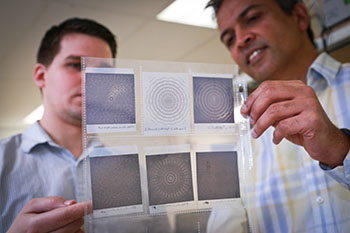
Utah graduate student Andrew Paulsen (left) and professor Ajay Nahata hold up a sheet of inkjet-printed terahertz frequency filters made through their newly developed process. [Image: Dan Hixson / University of Utah College of Engineering]
The quest for increased bandwidth is pushing wireless communication inexorably toward the terahertz (THz) frequency range—but the complex filter technology required to energize THz communication has faced persistent problems in design and implementation. Scientists from the University of Utah now report that they’ve devised a new technique for designing THz plasmonic filters using a widely available software modeling package, and fabricating those filters with an off-the-shelf inkjet printer (Optica, doi: 10.1364/OPTICA.2.000214).
In the work, Andrew Paulsen and Ajay Nahata are attacking one aspect of the so-called THz gap: the scarcity of workable technology in the spectral range from 100 GHz to 10 THz. Bridging that gap could open up the potential for orders-of-magnitude increases in wireless data transmission rates, and also for improving technologies such as medical imaging and security screening. While a variety of band-pass and other approaches to THz filtering have been devised, the scientists note that these approaches have all lacked versatility, making it hard to design arbitrary frequency responses within a single, scalable workflow.
Paulsen and Nahata went to a software package very familiar to scientists—MATLAB—to devise an approach to scalable filter design. The design method is basically an inverse approach, in which the designer first defines the frequency response desired from the filter; maps the filter response into “k space,” its frequency-domain representation, using a known simple relationship; and uses an inverse Fourier transform to create a spatial representation of the required filter.
That spatial design is then printed on a plastic sheet with an inkjet printer equipped with silver-metal ink, using a previously developed technique for gray-scale printing of plasmonic structures. Using that workflow, Paulsen and Nahata were able to design and fashion several classes of filters with different polarization dependence, anisotropy, resonance bandwidth and other characteristics.
While the demonstration is, at this point, largely a proof of concept, and will require further exploration and refinement before it can be leveraged commercially, the scientists see it as an important step on the road to a terahertz future. And, according to Nahata, there’s apt to be continual pressure for developing that part of the spectrum to empower future technologies. “I guarantee,” he said, “that people will come up with new ideas that can use all of that available bandwidth.”
